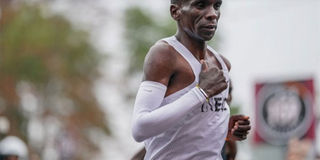What next for the great Kipchoge after doing the ‘impossible’?

Eliud Kipchoge during the INEOS 1:59 Challenge at Prater Park in Vienna, Austria on October 12, 2019. PHOTO | INEOS 1:59 CHALLENGE
What you need to know:
- Kipchoge’s coach Patrick Sang said they would retreat as a bigger group and discuss the Olympic champion’s next task
- Hermens said Kipchoge’s first stab at beating the sub-two hour barrier in Monza, Italy, in 2017 taught his management team a lot of lessons
- Innovation in the pacemaking positions also improved a great deal from the 2:00:25 Monza run
IN VIENNA
Eliud Kipchoge’s management will now meet to decide his next major assignment after Saturday’s sensational run in Vienna in which he became the first man to run the marathon in under two hours.
Of course, high up his priorities list is a defence of his Olympic title at the Tokyo Games.
He will almost certainly wish to tackle one more marathon before Tokyo, although it’s time now to relax and let his achievement on the streets of Vienna sink in.
Kipchoge’s coach Patrick Sang said they would retreat as a bigger group and discuss the Olympic champion’s next task.
And Jos Hermens, CEO of Global Sports Communication, the company based in Nijmegen, Netherlands which manages Kipchoge, told Nation Sport that the world marathon record holder will take some time to recover in Europe and attend official promotional engagements in the Netherlands before returning home.
“What Eliud has done today is epic,” Hermens, a former Dutch 10,000 metres champion and Athlete of the Year, said.
“I was hoping for this time (1:59:40) and I actually predicted this time… We were lucky that the weather was very good.
“Also we had a fantastic team from London Marathon (race organisers), INEOS (sponsors), the coaches and everyone.
“It was a tough journey to get everything ready for today and there were many people involved, and of course the most important person was Eliud and he delivered like nobody else can do,” added Hermens who paced Henry Rono to a world record (27:22.05) in the 10,000 metres here in Vienna in 1978.
“I’d like to thank coach Patrick Sang and all the Kenyans for their support – asante sana!”
FIRST STAB
Hermens said Kipchoge’s first stab at beating the sub-two hour barrier in Monza, Italy, in 2017 taught his management team a lot of lessons.
“We actually started planning for this in 2014 after Dennis Kimetto broke the world marathon record, and he was the first one to run a sub-2:03 time,” he explained.
In December, 2014, the sub-two project was started in partnership with sports and exercise science professor Yannis Pitsiladis and Ethiopian marathon legend, Haile Gebrselassie.
“We went to Nike and Nike adopted the project and so in May, 2017, we had the event in Monza and Eliud just missed it (by 26 seconds).” Hermens says the exclusive Monza run held at the Autodrome Nationale Monza Formula One racetrack, taught them three key lessons.
“First there were no crowds in Monza and we had a fantastic crowd today. Eliud really needed the crowd. “Second, the humidity here was much, much better than Monza, and the other problem in Monza was with the drinks, he needed to get more carbohydrates.
DOWNHILL
“And third, today we had a 100 per cent score in getting the fluids and carbohydrates to Eliud which we were handing out from a bike.
“We knew this course was going a little bit downhill and we were giving the drinks there, but in Monza we had a problem as we were giving the drinks uphill and he couldn’t drink enough.”
Innovation in the pacemaking positions also improved a great deal from the 2:00:25 Monza run, and with Kipchoge injury-free, Hermens and team couldn’t have hoped for anything better.
“It’s epic, it’s history, it’s wonderful…it’s a dream come true.”
While Hermens didn't want to give too much away about the Nike shoe that Eliud wore on Saturday, he agreed that a lot of work had been put into it since Monza.
“Look, I remember when Haile Gebrselassie, Patrick Makau and Dennis Kimetto broke the world record five, six times, they were all using the Adidas Boost shoe.
“We were then complaining to Nike that the Nike shoes were not good, because the Boost would give you more energy back when you hit the ground. He noted that Kipchoge’s shoe had a plate and some foam that provided extra cushion.





